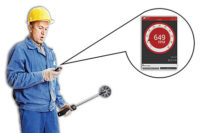Unsafe levels of carbon monoxide, carbon dioxide, and other toxic gases can threaten the health and safety of occupants inside buildings and homes. That’s why testing and monitoring IAQ is vital to maintaining the overall quality of the indoor environment. And, as the trend to build more energy-efficient structures continues, experts say there will be an even greater need for monitoring IAQ.
“As homes are built to be more efficient and tighter with fewer air leaks, the concerns for indoor air quality rise considerably,” said Kay Wasieleski, vice president, marketing and customer service, Bacharach Inc.
John Bickers, director, product management, Testo Inc., added this trend includes not only the residential sector, but also commercial.
“As homes and buildings are constructed tighter with less passive air exchange, the need to have and monitor active fresh-air ventilation is an increasing concern,” he said. “The tighter buildings can have increased issues regarding moisture, off-gassing, and fresh-air exchanges.”
Uncovering the Dangers
One of the greatest IAQ dangers of tighter buildings is the increased risk of carbon monoxide (CO) poisoning. According to Wasieleski, the trend of building tighter structures is here to stay. “This trend will not reverse, as new construction continues to reduce air leaks and energy drains,” she said. “Therefore, the concerns about carbon monoxide poisoning are very real, and awareness is high.”
Tom Jackson, CEO, Jackson Systems LLC, also stressed the need to monitor CO levels.
“One of the leading problems uncovered by IAQ monitoring is carbon monoxide levels,” he said, noting that unsafe CO levels can result from improper venting of gas appliances or leaks in the gas supply.
“According to the CDC [Centers for Disease Control and Prevention], more than 400 Americans die from unintentional CO poisoning every year, and more than 20,000 visit emergency rooms as a result of CO poisoning.”
While CO poisoning may be one of the most widely recognized and feared dangers of the indoor environment, there are other factors that IAQ devices must monitor and test to ensure the health and safety of occupants. “The most common parameters tested with IAQ monitors are carbon dioxide, carbon monoxide, temperature, and humidity,” Wasieleski said.
She further explained, “A basic indoor air quality instrument can measure temperature, humidity, and air ventilation using CO2 measurements that have a direct impact on comfort levels in a home or office. ASHRAE Standard 62 recommends an indoor CO2 level not to exceed about 700 ppm [parts per million] above outdoor ambient air, which is typically about 300-400 ppm.”
David P. Love, vice president, sales and marketing, Rotronic Instrument Corp., also emphasized the importance of monitoring CO2 levels.
“CO2 concentration can have the most immediate impact on occupant health and safety,” he noted.
Bickers added that monitoring humidity levels is also important.
“Proper control of moisture is a primary parameter for delivering comfort to inhabitants. In the case of high moisture, this provides an environment for mold growth, which can lead to poor, even dangerous, health conditions,” he noted.
Many of these dangerous conditions are the result of “drift” from original commissioning set points, according to Leah Friberg, education manager, Fluke Corp.
“Through change of time and occupants, system settings drift,” she said. “Testing and balancing, often called recommissioning or continuous commissioning, is required to restore appropriate levels of outside air, occupant comfort, and energy consumption.”
She continued, “While there is a risk to occupant health if appropriate levels of outside air are not maintained, the most dangerous problems are usually location specific: lack of pressure barriers allowing infections to spread in hospitals, for example, or failure to address temperature and humidity conditions conducive to mold growth.”
Poised for Growth
As the dangers of poor IAQ become more widely recognized, experts predict that both the residential and commercial markets will see growth in demand for IAQ monitoring and testing. Additionally, this growth may be driven by local government regulations.
“We foresee a demand in both residential and commercial buildings,” Jackson said. “As buildings and homes are more tightly sealed, there is little circulation of fresh air. This can lead to any number of IAQ problems, including high or low humidity levels, high VOC [volatile organic compound] levels, and sick building syndrome.”
Bickers suggested the residential market’s need for IAQ testing may grow as a result of less-informed homeowners and contractors not taking adequate measures to manage IAQ in the first place.
“It is likely the residential home market would have the greatest demand, as both the home builders and HVAC installers may not be properly aware of the implications and proper ventilation designs to accommodate the IAQ needs of tighter homes,” he said. “If this knowledge is not widespread or implemented, it will lead to an increasing population of homes needing IAQ testing and correction.”
Wasieleski added the trend toward home-performance contracting may also lead to growth in IAQ monitoring.
“In the residential sector, an increase in attention on whole-house energy performance will create some demand for energy efficiency, tighter houses, etc., and, therefore, increased attention on carbon monoxide and occupant safety,” she said.
On the commercial side, Love said he expects growth in IAQ demand from commercial office buildings, due to their large concentrations of people combined with ownership’s desire to minimize energy costs.
However, Friberg noted this growth will only be achieved if consumers are educated about the value of IAQ monitoring.
“Energy awareness continues to have a huge impact on IAQ testing. HVAC is frequently identified as the No. 1 energy consumer in the building, and yet, many times, energy-saving actions can damage air quality,” she pointed out.
However, she continued, “It’s quite possible to improve both air quality and energy consumption through recommissioning and potentially through capital equipment upgrades. The challenge is to market those services in tandem and educate the customer on value.”
The government may also play an increased role in driving demand for IAQ services.
According to Love: “CO2 regulations for indoor air quality in the U.S. lag Europe. We should expect more market demand and regulations limiting indoor exposure to CO2.”
And, as government building codes are changed to place higher priority on IAQ, the commercial market will follow the trend.
“Local and state government building codes are increasingly paying attention to minimum standards for the design and installation of mechanical ventilation systems. Commercial and institutional market sectors will have the most demand to keep up with the code requirements,” Wasieleski said.
Publication date: 7/14/2014
Want more HVAC industry news and information? Join The NEWS on Facebook, Twitter, and LinkedIn today!












Report Abusive Comment